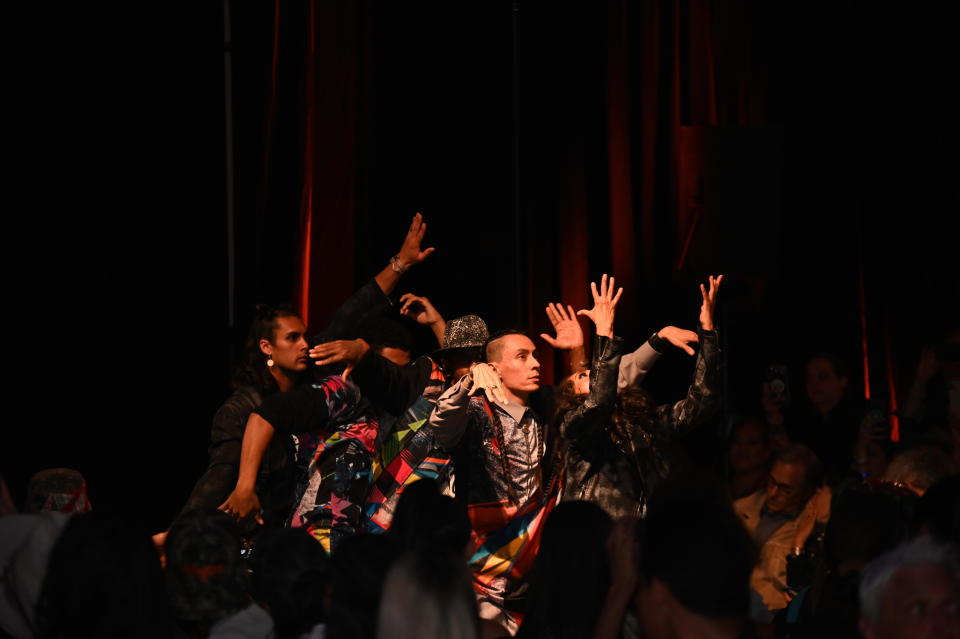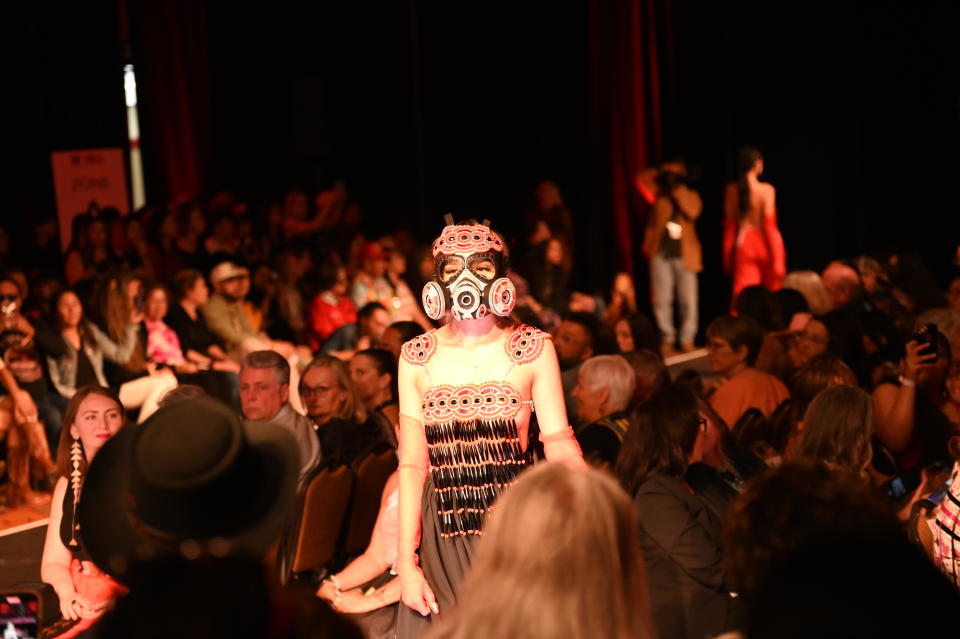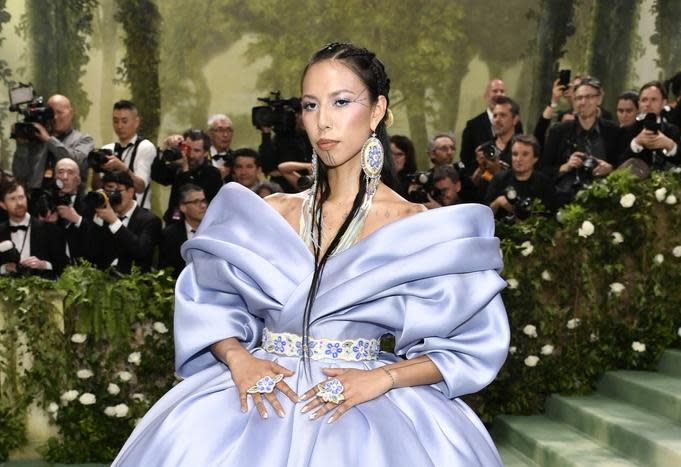Indigenous fashion takes the runway with an eye to history — and the future

Comanche chanting kicked off the Southwestern Association for Indian Art's inaugural runway show, as singer Marla Nauni opened with a blessing song for Native people. Peshawn Bread, the designer behind House of Sutai, quickly followed the prayer by sending a model in bell bottoms and roller skates down the runway to set the tone for her colorful disco-influenced collection.
It was the start of Native Fashion Week in Santa Fe, where dancers draped in reimagined indigenous looks twirled alongside models in nontraditional silks with Native motifs. They showed off creations that juxtaposed modernity and traditional Native ceremony.
Peshawn says she used elements of the 70s to represent a difficult time for indigenous people – when the American Indian Religious Freedom Act passed in 1978. The act protects Native American religious practices and customs, which had been illegal under previous laws.
"We were fighting for our practices and spirituality and didn't have time to go to the disco. Like you hardly saw any Natives in discos," said Bread. "… So, I wanted to say, well, in the 70s what if we had pure Indigenous joy? What would it look like? Would we incorporate our materials or designs like weaving patterns in our fabric?"
One of the largest gatherings of Native American fashion, more than 17 of the hottest Indigenous designers from across dozens of tribes in North America came together starting last weekend to celebrate their achievements outside of major fashion houses.
Amid pro-Palestinian demonstrations on college campuses and in front of the Met Gala, Navajo nation designer Carrie Wood pointedly addressed disparity in indigenous culture in America as well as expressed solidarity with the pro-Palestinian protesters in her collection. Wood sees the conflict Palestinians are facing as akin to the struggles of Native Americans. Her final piece to hit the runway and close out the first day of Native Fashion Week combined elements of Palestinian traditional garments juxtaposed against Native American dress. The model wore a Navajo-style tiered skirt made out of the Palestinian keffiyeh. Wood connected the similar use of accessories such as scarves and jewelry in both cultures to unify the style.
Many designers noted the difficult history, expressing fears that Native peoples are seen as a monolith, relegated to history — a lack of nuance that drives many Native artists to be protective of their work.

Amber-Dawn Bear Rope, who is part of the Siksika nation in Alberta, Canada, and the director of the Southwestern Association for Indian Arts, which put on the four-day event, started the organization on a shoestring budget in 2014. She hopes the show is the launching pad for many within the indigenous community to create their own unique brand after generations of being forced to fit a cultural mold.
"This is creating our own space for us to meet and have an experience within our own worldview of fashion and indigenous design," she said. "Native American artists were the original courtiers of fashion in North America."
Events like the fashion week, she said, are a way for Native American creatives to take back the narrative on what it means to be indigenous.

Kayla Lookinghorse-Smith, an up-and-coming Lakota-Dakota Sioux designer, hopes to bridge the gap between history and modern design, "[my work] doesn't take away from our protective ceremonial garment or our stories. It speaks to two worlds. We have to walk in today's society, and we have to remember who we are," Lookinghorse-Smith said.
Mainstream interest in Indigenous dress and culture in the wake of the award-winning film "Killers of the Flower Moon," based on the bestselling book of the same name, TV series "Reservation Dogs" and other Native-focused entertainment is driving designers and attention to their work.
Celebrities such as Lily Gladstone and Quannah Chasinghorse are drawing attention to indigenous pieces on the red carpet and award ceremonies. At this year's Met Gala, Chasinghorse wore jewelry from beadwork artist Heather Dickson to pair with her custom H&M dress. Meanwhile, Gladstone's Met Gala gown incorporated embroidered star-shaped jewelry from renowned Great Plains artist Keri Ataumbi.

Bread's mother, Jhane Myers, a producer and Native consultant on Hollywood productions including 2022's "Prey" and Showtime's "The Curse," sees the renewed attention on Native culture as a cyclical trend. She said she's seen support build every 25 years, but it dissipates before Natives reach true success. Myers, who has also collaborated with major fashion labels such as Ralph Lauren as part of her work with the Indigenous fashion community, believes that this moment will be different — because Indigenous creatives are working within Hollywood as directors, writers and producers, so the wider narrative can be influenced by those who understand it.
Comanche and Cherokee designer Bread hopes with Hollywood interest and events like SWAIA's Native Fashion Week, Indigenous dress and designers can catch the eyes of larger fashion houses and brands.
Already, her close friend, Diné weaver Naomi Glasses, has gone from a fellowship with former Chloe creative director Gabriela Hearst as part of Creative Futures, which provides opportunities for creatives, to now working on a major collaboration with Ralph Lauren. Bread said that these opportunities allow Native designers and brands to work together ethically instead of facing potential struggles with appropriation.
Designer Heather Bouchier from Beardyʼs & Okemasis' Cree Nation in Saskatchewan Treaty Six Territory in Canada says that Native celebrities have given her the chance to walk her dresses down red carpets. One of her dresses, fitted for a high-profile Native American actor at the Canadian Screen Awards, will feature pieces made out of 3D printed dentalium shells, an Inuit or First Nations tusk-like jewelry often used in commerce. She says because the material is rare, she takes a sustainable approach to design by 3D-printing the shells.
Actor Wes Studi, who has received an Academy Honorary Award for his roles in acclaimed films such as "Dances with Wolves" and "Last of the Mohicans," attended the SWAIA fashion show to watch his granddaughter's debut appearance as a runway model. Over the past several decades, acting roles for Native Americans have been inconsistent. But watching his granddaughter blossom in her modeling career is a moment of generational impact.
New details emerge after series of resignations rock Miss USA organization
Decade-long search for Texas mom's killer takes stunning turns
Bodycam video released of deadly police shooting of U.S. airman in Florida

